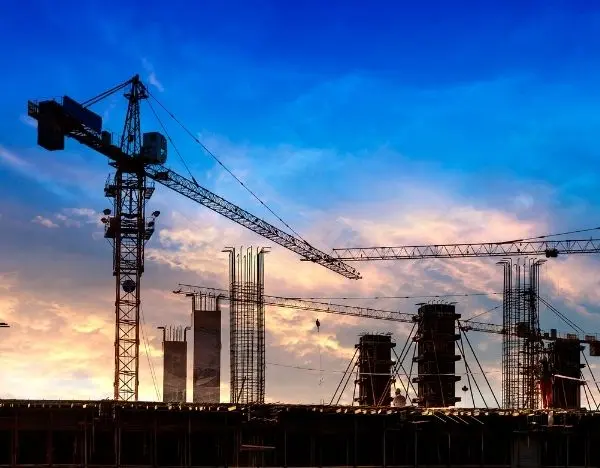Ready to Fight for You
What To Do If You are Injured On a Construction Site
Construction sites are bustling hubs of activity where safety should always be a top priority. However, accidents do happen, and if you find yourself injured on a construction site, it’s crucial to know the steps to take to protect both your health and legal rights. This guide provides comprehensive tips on what to do if you are injured on a construction site.
What To Do If You Are Injured On a Construction Site

In the critical moments following a construction site injury, prompt and informed actions are key to safeguarding your health and legal rights. This section outlines essential immediate steps to effectively manage the situation, ensuring your safety and laying the groundwork for any necessary legal action.
Seek Medical Attention Immediately
Your health is the utmost priority. Even if your injuries seem minor, underlying problems may not be immediately apparent. Getting prompt medical attention ensures your injuries are professionally assessed and documented, which is vital for any subsequent legal claims.
Report the Incident
As soon as possible, report the injury to your supervisor or site manager. This official report is an essential record of the incident and helps in initiating the process for workers’ compensation claims.
Document Everything
If you are able, take pictures of the accident scene, your injuries, and any equipment or conditions that may have contributed to the incident. Collect names and contact information of any witnesses. This information can be crucial in constructing a detailed account of the event.
Do Not Sign Any Documents Without Understanding Them
In the aftermath of an injury, you might be presented with documents from your employer or insurance representatives. It’s important not to sign anything until you fully understand its implications, as some documents might waive your rights to future claims.
Understanding Your Rights and Legal Options
Workers’ Compensation Claims
In most cases, construction workers are covered by workers’ compensation insurance, which can provide medical benefits and a portion of your wages. However, these claims do not cover pain and suffering and might not fully compensate for severe injuries.
Third-Party Claims
If your injury was caused by someone other than your employer, such as a subcontractor or equipment manufacturer, you might have a third-party claim. These claims can provide additional compensation beyond what workers’ compensation offers.
Legal Consultation
Considering the complexities surrounding construction site injuries, consulting with a legal professional experienced in this field is advisable. They can help navigate through workers’ compensation claims, identify potential third-party claims, and ensure your rights are fully protected.
Long-Term Considerations
Follow-Up Medical Care
Follow your doctor’s recommendations and keep all appointments. Consistent medical care is not only vital for your recovery but also establishes a documented history of your injuries and treatment, which is important for any legal claims.
Keep Records of All Expenses and Lost Wages
Document all expenses related to your injury, including medical bills, travel expenses to medical appointments, and any lost wages. This documentation is critical in seeking appropriate compensation.
How a Construction Accident Attorney Can Help
Navigating the aftermath of a construction site injury can be complex and overwhelming. This is where the role of a construction accident attorney becomes invaluable. A legal professional with experience in construction accident cases can provide comprehensive support and guidance, making a significant difference in the outcome of your case. Here’s how a construction accident attorney can assist you:
Legal Experience in Construction Accidents
Attorneys in this field possess a deep understanding of the laws and regulations governing construction sites, workers’ compensation, and personal injury. They can accurately interpret how these laws apply to your specific case.
Investigation and Evidence Gathering
A skilled attorney will thoroughly investigate your accident, gathering crucial evidence such as accident reports, witness statements, and medical records. This robust collection of evidence is essential in building a strong case.
Navigating Workers’ Compensation
While workers’ compensation can provide some relief after being injured on a construction site, it may not cover all your expenses and losses. A construction accident attorney can help ensure you receive all the benefits you’re entitled to under this system.
Identifying Third-Party Claims
If your injury was caused by a third party, such as an equipment manufacturer or a subcontractor, an attorney can identify and pursue these additional claims, which can lead to further compensation.
Handling Insurance Companies
Dealing with insurance companies can be daunting. Your attorney will handle all communications and negotiations with these companies, advocating for your best interests and ensuring you’re not pressured into accepting a low settlement.
Maximizing Your Compensation
An experienced personal injury lawyer knows the true value of your claim and will work diligently to secure compensation that covers all your medical expenses, lost wages, pain and suffering, and any other damages.
Representation in Court
If a fair settlement cannot be reached, your construction accident attorney will be prepared to take your case to court, providing you with legal representation throughout the trial process.
Support and Guidance
Beyond the legal aspects, having a construction accident attorney means you have a supportive advisor through this challenging time. They can offer guidance on medical treatments, rehabilitation options, and the overall management of your case.
Common Construction Site Accident Injuries
Construction sites, with their array of activities and equipment, present numerous hazards, leading to a variety of injuries. Understanding common construction site accident injuries is crucial for workers and employers alike, as it underscores the importance of safety protocols and preparedness in handling accidents. Here’s a look at some of the most frequent injuries that occur on construction sites:
Falls from Heights
One of the leading causes of injuries on construction sites, falls from ladders, scaffolding, roofs, or other elevated platforms can result in severe injuries such as fractures, spinal cord injuries, or even fatalities.
Slip and Fall Accidents
Slippery surfaces, uneven terrain, or obstacles can lead to slips and falls, causing injuries ranging from minor bruises to more serious conditions like broken bones or head injuries.
Struck-by Object Incidents
Workers can be injured by falling objects, swinging construction materials, or debris. These accidents often result in head injuries, including traumatic brain injuries (TBIs).
Electrocution
Exposure to live wires, faulty electrical equipment, or power lines can lead to electrocution, causing burns, nerve damage, and in severe cases, can be fatal.
Caught-in/between Accidents
These occur when a worker is caught in or compressed by equipment or objects, or struck, caught, or crushed in collapsing structures, leading to crushing injuries, amputations, or death.
Machinery Accidents
Injuries from operating heavy machinery, such as forklifts, cranes, or bulldozers, can range from cuts and lacerations to more severe injuries like amputations or crush injuries.
Exposure to Harmful Substances
Prolonged exposure to hazardous chemicals, dust, or toxic substances can lead to respiratory illnesses, skin conditions, and other long-term health issues.
Repetitive Motion Injuries
Continuous use of tools or repetitive motions can cause strain and lead to conditions like tendonitis or carpal tunnel syndrome.
Noise-Induced Hearing Loss
Constant exposure to high noise levels without proper ear protection can result in temporary or permanent hearing loss.
Heat Stress and Sun Exposure
Working in extreme heat or direct sunlight without proper hydration and protection can lead to heatstroke, dehydration, and sunburn.
What Damages Can a Construction Accident Lawsuit Pursue?
When a construction workers has been injured on a construction site, they may have the right to pursue legal action beyond workers’ compensation claims. A construction accident lawsuit can seek various forms of damages, which are financial compensations for losses and hardships resulting from the injury. Understanding these damages is crucial for victims to comprehend the full scope of their legal rights and potential compensation. Here are the key types of damages that can be pursued in a construction accident lawsuit:
Medical Expenses
This includes the cost of immediate medical treatment, hospital stays, surgeries, medications, and any ongoing medical care such as physical therapy or rehabilitation. Future medical expenses can also be claimed if the injury requires long-term or life-long medical attention.
Lost Wages and Earning Capacity
If the injury results in time off work, a lawsuit can seek compensation for lost wages. Moreover, if the injury impacts the victim’s ability to work in the future, compensation for the loss of earning capacity can also be pursued.
Pain and Suffering
This non-economic damage compensates for the physical pain and emotional distress suffered due to the injury. It includes compensation for chronic pain, discomfort, anxiety, stress, and the overall decrease in quality of life.
Disability and Disfigurement
In cases where the injury leads to permanent disability or disfigurement, the victim can seek damages for the long-term impact on their life, including changes in lifestyle, inability to engage in leisure activities, and the psychological impact of living with a disability or disfigurement.
Punitive Damages
While less common, punitive damages may be awarded in cases where the defendant’s conduct was particularly reckless or egregious. These damages are intended not just to compensate the victim, but also to punish the wrongdoer and deter similar conduct in the future.
Loss of Consortium
This applies if the injury adversely affects the relationship between the victim and their spouse. It compensates for the loss of companionship, affection, and support that results from the injury.
Wrongful Death
In the tragic event that a construction accident results in death, the victim’s family can file a wrongful death lawsuit. This can include damages for lost future income, funeral and burial expenses, and loss of companionship.
Legal Fees and Costs
In some cases, the lawsuit can also seek to recover the costs associated with pursuing legal action, including attorney fees and court costs.
Need Legal Assistance After a Construction Accident? Contact Us Today
If you’ve been injured on a construction site, don’t navigate the complexities alone. Our experienced attorneys are here to guide you through every step of your legal journey, ensuring you get the compensation and justice you deserve. Contact The Law Offices of Mark E. Weinberger P.C. for a consultation and let us advocate for your rights.
FAQs About Construction Accident Lawsuits
Who can be held liable in a construction accident?
Liability in a construction accident can fall on various parties, including employers, contractors, equipment manufacturers, or other third parties. Determining liability often depends on the specific circumstances of the accident, such as negligence, failure to adhere to safety protocols, or defective equipment.
Can I sue for a construction accident if I’m receiving workers’ compensation?
Yes, you may still have the right to sue responsible third parties, even if you are receiving workers’ compensation. Workers’ compensation typically does not cover pain and suffering or punitive damages, which can be pursued through a personal injury lawsuit.
What is the statute of limitations for filing a construction accident lawsuit?
The statute of limitations varies by state. Generally, it ranges from one to three years from the date of the accident. It’s crucial to consult with an attorney as soon as possible to ensure your lawsuit is filed within the legal time limits.
Do I need a lawyer to file a construction accident lawsuit?
While not legally required, having a lawyer can significantly improve your chances of a successful outcome. Construction accident cases can be complex, involving multiple parties and intricate legal issues. An experienced attorney can navigate these complexities and help maximize your compensation.
How long does a construction accident lawsuit take?
The duration of a construction accident lawsuit varies widely. Factors that impact the timeline include the complexity of the case, the number of parties involved, and the willingness of parties to settle. Some cases resolve in a few months, while others may take years.
What if the accident was partially my fault?
You may still be able to recover damages even if you were partially at fault, depending on your state’s laws. Many states follow comparative negligence rules, allowing you to recover a percentage of the damages based on your degree of fault.
What should I do immediately after a construction accident?
Seek medical attention, report the accident to your supervisor, document the scene and your injuries, and avoid signing any documents or making detailed statements without consulting a construction accident lawyer.
What types of evidence are important in a construction accident lawsuit?
Key evidence includes accident reports, witness statements, medical records, photos of the accident scene, and documentation of your injuries and lost wages.
Can I claim compensation for emotional trauma after a construction accident?
Yes, you can seek damages for emotional trauma and mental anguish, commonly referred to as pain and suffering, as part of a personal injury lawsuit.
Are there special considerations for independent contractors in construction accidents?
Independent contractors may not be eligible for workers’ compensation but can often pursue legal claims against negligent parties. The specifics depend on the contract terms and the accident circumstances.
How Can We Help You?
Fields marked with an * are required
"*" indicates required fields




